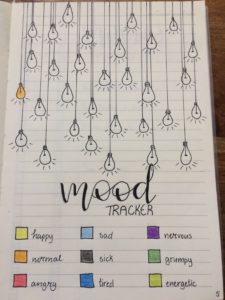How And Why To Keep A Mood Journal
“The habit of writing for my eye is good practice. It loosens the ligaments.” — Virginia Woolf
Journal writing is the process of recording personal insights, reflections and questions on assigned or personal topics
Writing about your inner life is a useful practice for getting ideas out of your head and onto the blank page.
What is a mood journal?

Image source – iStock
It’s not the regular journal of just regular activities. Mood journal is a way to identify and take action around your feelings.
When you note down your moods and emotions it helps you to understand yourself way better. This way you are able to track your emotions. It does not limit to just yourself. You can even notice people or places that are triggers and recognize warning signs of your strong emotions.
It is highly recommended for people who go through depression or anxiety. It tends to reduce the effect and make them feel calm.
The Mood Journal is actually designed to help you trace and monitor your feelings in a much better way. If you stick to it and use it correctly, you can begin to get around your own defenses.
When put things down on a paper, it makes a clear picture of the cause of your issue. The moment you see the cause clearly, you will be able to figure out the solution for it as well. It ultimately brings clarity to your mental health. You will be able to recognize your patterns and then make way to break it for the good.
When to start a mood journal?
“You can’t manage what you don’t measure.”
– Peter Drucker
The fact is unless an individual is able to organize, analyse and process the data they’re working with, it will difficult to reach an accurate conclusion.
It important to know what exactly is the issue and keeping it down on a blank paper will help you figure it out.
To begin with, you don’t have to buy a journal or a mood journal from store to start writing. You can use one of your notebooks or an empty diary (unless new stationary inspires you to write).
Find the time to write in it. You may need a quiet atmosphere or you may be comfortable writing it anywhere. In that case a café, your office, anywhere you are just ready to write – you can give it a start. But if quiet is your comfort zone then you can take out time before bedtime or right after you wake up. You can even find space during office hours. Take some minutes out in your break time and start filling it up.
How to keep a mood journal?
There is no particular way to write a mood journal. It is a personal thing and you can keep and design it any way you want to. Although, if you are stuck with where and how to begin and go on with it, you can follow the steps given below and make it easier. These are some of the basics that you can follow to get it started and flowing.
- Date, day and time
This one is how you begin. You may as well scribble away if you are not so organized and that’s okay too. Its your journal and has to feel like you. But to maintain a track of all your records – you need to go back and see that particular date and time. The major goal of writing a mood journal to figure out your moods and then eventually go back and measure the changes. You can measure only when you have something to compare your present with. Always mention the date/month/year when you start writing your day’s mood journal. If you tend to write multiple times in a day, you can mention the time as well. It will only help you to get clarity.
- Name your emotion

Image source – Pinterest
You are basically born with eight wired emotions as per the psychologists. These are called the primary emotions.
Here is a list of primary emotions:
- Anger: fury, outrage, wrath, irritability, hostility, resentment and violence.
- Sadness: grief, sorrow, gloom, melancholy, despair, loneliness, and depression.
- Fear: anxiety, apprehension, nervousness, dread, fright, and panic.
- Joy: enjoyment, happiness, relief, bliss, delight, pride, thrill, and ecstasy.
- Interest: acceptance, friendliness, trust, kindness, affection, love, and devotion.
- Surprise: shock, astonishment, amazement, astound, and wonder.
- Disgust: contempt, disdain, scorn, aversion, distaste, and revulsion.
- Shame: guilt, embarrassment, chagrin, remorse, regret, and contrition.
These emotions combine and may end up bringing other different types of emotions. You may not able to name them exactly but you can write and understand what caused it initially. The initial emotion may be a primary one and it may lead you to the emotion which you are exactly feeling at the moment.
Its okay even if you can’t name it at the moment. Just writing in detail about it will clear a lot of thoughts.
- Point the cause
When we pause for a bit of self-reflection, we can usually identify the situation triggering an emotion.
For example, it wasn’t your kids arguing or the mess they made. Maybe it started the moment you were overloaded with work at office.
This is your personal space to write and you must be completely honest here. Take a moment and point out what caused it. Even if the cause seems blurry or you may see multiple causes – write them all.
- Note your reaction for that situation
You can’t really resist a reaction. It is the most human thing but you can certainly assess if that reaction was appropriate or even needed.
It is possible you might have reacted with rage, frustration or even screaming. The other emotional reactions can be locking yourself and crying and even guilt sometimes.
To keep the journal honest, you have to note down your honest reaction (without initial explanation). Don’t try to justify your reaction – just note it down.
- Was the reaction appropriate?
To calculate the accuracy, you have to see the situation first – the circumstances that led to this reaction compared with your reaction.
If the reaction seems senseless, unreasonable or just not appropriate then you know you need to change it.
- Finding the solution
Don’t look for a quick fix. To be honest, there are none.
But if you are willing to take it further and actually bring a change – then you are doing it right. After following all the above steps, the last step is to finally see for yourself – “What you want to do about it?”
If the situation feels like it can be changed – then you can definitely go ahead and make an action plan for it.
Begin with analysing the better solution for that situation. For example, you screamed at your partner when they were pointing out some of your mistakes. Now see to it that in this situation you may have chosen a better reaction or solution. You could have taken a few seconds back and then asked them what they want you to do about them or how can you make it better. Just simple acknowledging and stating that you will try to improve will be a better way of dealing with this.
Although, you may face some situations that may not seem to be in your hands at all. In this situation, its wiser to accept the concept of “distress tolerance”. It is an individual’s perceived capacity to withstand negative or difficult emotions.
If you feel yourself experiencing a distressing emotion you can just take a short break from it to move further and get clarity or just maybe get it out of your head. You can consider taking a short walk, taking 5-10 slow breaths or listening to your favorite song. Make a list of songs that help you calm down and you can use this playlist at such moments. You can write down the moment’s feeling or just about how you are getting through it in your mood journal.
While you are keeping a mood journal and recording everything, keep in mind that you cannot expect an immediate solution. In some situations, you may feel better immediately but only if it was just a moment’s rage or something unreasonable. Keep in mind that coming to terms with those heavy emotions may take a while. You will initially find out what works for you.
Until then you can keep the record and make it better with each writing.













